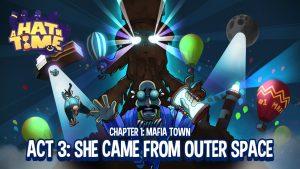A Hat in Time was kickstarted in 2013 to be an attempt at a modern take on 3D platformers of the ’90s. After the success and several years the game is finally out. While it doesn’t quite hit the same mark as the games it was emulating, A Hat in Time does prove that there are still stories to tell and collectibles to collect.
Time Skipping:
The story follows an alien girl who is traveling around a planet with her time-powered ship. When a crazy incident happens, she finds herself stuck without the fuel to get home. The game is split between five chapters made up of various acts.
Each act has a task for you to achieve to collect a magical hourglass, which is the game’s mcguffin. Hatgirl’s moveset should be familiar to anyone who has played a 3D platformer: Running, double jumping, wall jumping and so on.
What’s unique to the game is the ability to wear different hats that provide a special benefit. As you explore the various acts, you’ll find yarn balls that will be used to create them. The only way to find everything is to craft all the hats. Additional equipment comes in the form of an upgradeable umbrella and pins that provide passive benefits.
With that said, a 3D platformer is only as good as its level design, and this is where A Hat in Time fluctuates.
A Hat Trick:
To its credit, A Hat in Time features five very different acts to play around in. Unlike other 3D platformers that keep the same basic rules throughout each world, A Hat in Time tries to be as creative as possible.
One world has you exploring a haunted forest while performing tasks for a ghost. In act three, how you play the various chapters will determine the ending level. The game also features rift challenges that put you in platforming segments to reach the hourglass.
Most levels take place in very wide environments; encouraging exploration.
The game downplays the obsessive need to collect every item in the world for completion. There are always way more yarn balls than what you need to create your various hats, and the game’s version of money always generates more when you return to a chapter instead of having a fixed amount.
For what’s there A Hat in Time is a good experience, but it doesn’t hit the same heights as the games it was paying homage to.
Ripped Seam:
There’s nothing here that makes me condemn A Hat in Time, but I have a few overall issues. The level quality varies depending on the act you’re playing. For a game with only five chapters worth of content (one being just one stage), I was expecting more in terms of quality. Some acts can take upwards of 15-20 minutes to beat, while others can take about five minutes. The hidden challenges are a nice touch, but are purely platform exercises.
The boss fights tend to drag on with multiple phases that aren’t changing the basic strategy. Several fights felt like they took forever, while others were over in a matter of minutes. I never got that same excitement out of a boss battle like I did with Super Mario Galaxy.
The progression of the game is also weird. I was able to beat the game without even stepping foot into one of the game’s chapters. The use of hats was also downplayed, with them acting more as keys rather than useful mechanics. Outside of quest specific instances, I never needed to switch my hat for anything.
Control-wise, A Hat in Time does suffer from a somewhat spastic camera. I had cases where it seemed to have a life of its own and would give me the wrong angle for what I was trying to do. The game also has a habit of feeling a little out of control when you’re trying to jump around walls without initiating a wall jump.
Tip of the Hat:
A Hat in Time is a clever take on a genre that once popularized the AAA industry. While it may not hit every step perfectly, there is enough charm and variety to keep you going until the credits.


